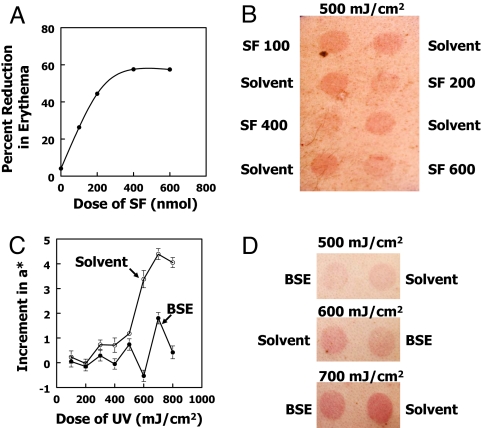Fig. 3.
SF-rich BSEs protect human skin against erythema caused by 311-nm UVR. (A) Inhibition of skin erythema development by topical treatment of a male volunteer with a range of SF doses. The circular 2.0-cm-diameter spots received 100, 200, 400, or 600 nmol SF as BSE in 25 μl of 80% acetone/20% water on 3 days at 24-h intervals. Control spots received 25 μl of solvent only. Chromometer measurements of a* were obtained 4 days before radiation with 500 mJ/cm2 of UVR and 24 h after radiation. The 4-day mean a* value for the solvent-treated areas before radiation was 6.70 ± 1.16. Inhibition of erythema formation (%) was calculated from [a* (untreated) − a* (treated)/a* (untreated)] × 100. The untreated values (zero dose) were calculated from the increment of two areas that received 25 μl of BSE in 80% acetone/20% water containing 400 nmol of unhydrolyzed glucoraphanin (the inactive glucosinolate precursor of SF). (B) Photograph of four pairs of spots of individuals (described in A) who received 100, 200, 400, or 600 nmol doses of SF (as BSE) or solvent only. (C) Effect of topical treatment with SF-containing BSE on erythema response to a range of doses of UVR. With the use of 16-window template, horizontally adjacent pairs of spots were treated with either 200 nmol of SF in 25 μl of 80% acetone/20% water or solvent alone on 3 successive days at 24-h intervals and 24 h later were radiated with 100–800 mJ/cm2 of UVR. The increments in a* values for each spot after UVR with respect to their 4-day means before UVR are plotted as a function of UV dose. The visually determined minimum erythema dose was 600 mJ/cm2. (D) Photographs of pairs of BSE- and solvent-treated spots that received 500, 600, or 700 mJ/cm2 of UVR. The complete set of percent reduction values for this subject are shown in Table 1 (subject 2).

